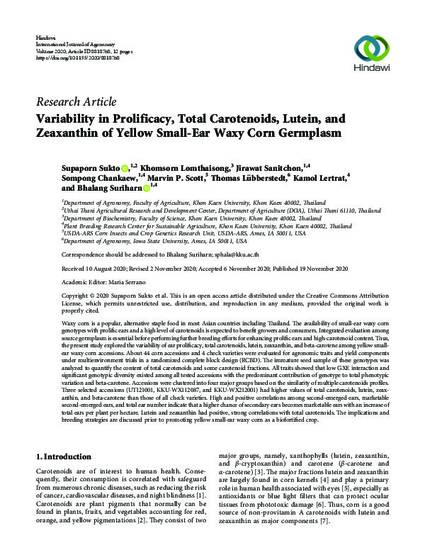
Waxy corn is a popular, alternative staple food in most Asian countries including Thailand. The availability of small-ear waxy corn genotypes with prolific ears and a high level of carotenoids is expected to benefit growers and consumers. Integrated evaluation among source germplasm is essential before performing further breeding efforts for enhancing prolific ears and high-carotenoid content. Thus, the present study explored the variability of ear prolificacy, total carotenoids, lutein, zeaxanthin, and beta-carotene among yellow small-ear waxy corn accessions. About 44 corn accessions and 4 check varieties were evaluated for agronomic traits and yield components under multienvironment trials in a randomized complete block design (RCBD). The immature seed sample of these genotypes was analyzed to quantify the content of total carotenoids and some carotenoid fractions. All traits showed that low GXE interaction and significant genotypic diversity existed among all tested accessions with the predominant contribution of genotype to total phenotypic variation and beta-carotene. Accessions were clustered into four major groups based on the similarity of multiple carotenoids profiles. Three selected accessions (UT121001, KKU-WX112087, and KKU-WX212001) had higher values of total carotenoids, lutein, zeaxanthin, and beta-carotene than those of all check varieties. High and positive correlations among second-emerged ears, marketable second-emerged ears, and total ear number indicate that a higher chance of secondary ears becomes marketable ears with an increase of total ears per plant per hectare. Lutein and zeaxanthin had positive, strong correlations with total carotenoids. The implications and breeding strategies are discussed prior to promoting yellow small-ear waxy corn as a biofortified crop.
Available at: http://works.bepress.com/thomas-lubberstedt/118/

This article is published as Supaporn Sukto, Khomsorn Lomthaisong, Jirawat Sanitchon, Sompong Chankaew, Marvin P. Scott, Thomas Lübberstedt, Kamol Lertrat, Bhalang Suriharn, "Variability in Prolificacy, Total Carotenoids, Lutein, and Zeaxanthin of Yellow Small-Ear Waxy Corn Germplasm", International Journal of Agronomy, vol. 2020, Article ID 8818768, 12 pages, 2020. doi: 10.1155/2020/8818768.